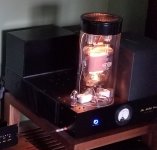I built this amplifier 3 years ago, initially with a 9002 front end, AC coupled to a 6C4 cathodyne PI. Eventually modified to a triode strapped pentode front end, fixed bias 6C4 cathodyne, and now, a pentode front end DC coupled to the 6C4 cathodyne. I developed (f**cked around but wrote things down) the first stage using the 5654/6AK5 tube, which worked well with a B+ of around 100V. -4dB of GNFB. The amp measured 0.3% THD+N at 2.83V, 1kHz, but things start to go down hill fast after that. Fortunately, 99.99% of my listening is done at a level less than that. Output is about 7W RMS. With the previous triode strapped pentode topology, I was able to swap in a whole host of different tube for funsies. I didn't think I would be able to do so with a pentode front end, but just for giggles, I tried. Surprise, surprise, all the different tubes I tried worked (6AJ5, 6BH6, 6186W, 6AU6, 6CB6A, 6DE5, 6DK6). There was no weirdness on the oscilloscope, though I didn't bother to measure each different tube. I just noticed that the gain was different, but not by much. Interesting thing is that when I first breadboarded the pentode front end, I tried the 6AU6 first, and it did not like the low voltage. The sine wave on the oscilloscope looked all weird and asymmetrical. I guess the negative feedback calmed things down quite a bit.




Well, I couldn't leave well enough alone and bypassed the cathode of the driver pentode and upped the negative feedback to -11dB. The amp remained nice and stable, but absolutely no difference in the distortion spectrum. It looks like the distortion characteristics are dominated by the 832A tubes. At 7W output, the THD+N is greater than 30%! Who would have guessed that a WWII VHF tube is not very good at audio! 😛
I don't have any of the Chinese FU-32 tube, but I have a bunch of the Soviet GU-32 tubes. With the best matched pair, the distortion was basically the same as my best 832As (0.35% THD+N vs 0.3% at 1 W output). Just like the 832A, the GU-32s were well above 30% THD+N at 7 W. These tubes were made for class C operation so linearity was never a consideration.
I'm such an idiot. I totally forgot to put a voltage divider going from the speaker load resistor to my USB audio interface (Steinberg UR12). Up to 2.83 volts was just fine for line level input, but above that, I was overdriving the audio interface, and therefore the crazy high distortion numbers. Luckily, the Steinberg seems to be ok. The actual distortion number for the 832A and GU-32 tubes are around 1.5% THD+N at 7W output. There I was, badmouthing the poor tubes.😛
7W is very low from such tubes , if you aim at 20-30W even if you don't use it , probably the sound quality would be better
Those long, loopy plate leads are probably resonant n that circuit somewhere >100MHz.
There could be a problem with that effecting the amps audio performance.
Something like 100R , 1/2 watt CC resisters right at the anode connexion is worth a look.
I'm thinking 7W audio may not be far off the mark. Did anyone draw the load lines on the plate curves to calc the correct number?
Or just throw a dart because someone said it 'sounded OK'?🙂
There could be a problem with that effecting the amps audio performance.
Something like 100R , 1/2 watt CC resisters right at the anode connexion is worth a look.
I'm thinking 7W audio may not be far off the mark. Did anyone draw the load lines on the plate curves to calc the correct number?
Or just throw a dart because someone said it 'sounded OK'?🙂
Are you sure about 20/30W with the 832? I'd expect that with the 829, but the 832 has half the maximum plate dissipation (15W for the whole tube) .7W is very low from such tubes , if you aim at 20-30W even if you don't use it , probably the sound quality would be better
The 6C4 voltages don't seem to be plausible. At a plate voltage of 130 V, a grid voltage of -10 V nearly cuts off this triode. Please check again!
Best regards!
Best regards!
What matters is plate to cathode voltage, 192-61=131?? The 6C4 plate is at 192V
I mixed up the voltages between the 5654 and the 6AJ5. For the 5654, the plate was 51V, but the voltages of the 6C4 was 57V at the cathode and 196V at the plate. The 6AJ5 plate voltage was 55V and the 6C4 voltage was what I put in the schematic. It's really neat that the 6C4 biases itself so that the grid is around -6V relative to the cathode. The higher transconductance tubes have lower plate voltages, and the 6C4 always bias itself to about the same amount. The 6DE6 tube with a transconductance of 8000 umhos had a plate voltage of 45V and the 6C4 biased itself to 51V and 201V.
- Home
- Amplifiers
- Tubes / Valves
- 832A Three Years On
